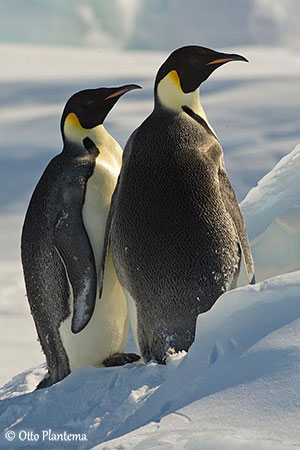
Text by Nicole Bouglouan
Photographers:
Jean Michel Fenerole
Photos d’Oiseaux du monde
Patrick Ingremeau
TAMANDUA
Tom Merigan
Tom Merigan’s Photo Galleries
Niraj V. Mistry
Photo Galleries
Otto Plantema
Trips around the world
Ingo Waschkies
Bird Photography
Philippe et Aline Wolfer
OISEAUX D'ARGENTINE
Nicole Bouglouan
PHOTOGRAPHIC RAMBLE
Sources:
Around the World for Penguins - Where to see all the 18 penguin species - Text and photo’s: Otto Plantema – Printed in 2020 - Lay out: Henry Meulman and Otto Plantema - 168 pages
(Revenues from this book will granted to Birdlife’s Marine Programme)
HANDBOOK OF THE BIRDS OF THE WORLD vol 1 by Josep del Hoyo-Andrew Elliot-Jordi Sargatal - Lynx Edicions - ISBN: 8487334105
L’ENCYCLOPEDIE MONDIALE DES OISEAUX - Dr Christopher M. Perrins - BORDAS - ISBN: 2040185607
BirdLife International (BirdLife International)
Animal Diversity Web (University of Michigan Museum of Zoology)
PhotoVolcanica - Photography and Information by Dr Richard Roscoe
PENGUINWORLD (Lloyd Spencer Davis)
Penguins of the world (Mike Bingham)
Les Manchots (François Durand)
Wikipedia, the free encyclopaedia
ANIMALS – Explore, discover, connect
CREAGUS@Monterey Bay (Don Roberson)
SPHENISCIDAE FAMILY
Penguins
Sometimes, it could be difficult to consider penguins as birds. These “animals” are able to walk on land with upright stance like humans, and to swim in deep water like fish. They are both flightless and aquatic.
Traditional associations confirmed by DNA analysis, lead to Gaviiformes and Procellariiformes as closest relatives, but also indicates affinities with the highly aerial Fregatidae.
Regarding some details, as well physical or behavioural, the birds’ features appear. The bill is that of a bird and the flippers are their wings, and although they only fly underwater, the movement is similar to wingbeats in the air.
The Spheniscidae family contains eighteen species and six genera, separated by physical appearance, range and behaviour.
Between the highly adapted Emperor Penguin and the funny crested penguins, several other species have a great presence too, with an unusual range in the tropics. Penguins are not only related to snow and ice, but also to lava fields, rocks, dense coastal forest and steep slopes according to the range.
All are highly marine and occur only in the Southern Hemisphere. They need cold waters for foraging, and although some of them are living in warmer regions, they can benefit from cool currents from Antarctica.
An interesting family which is worth studied!
All penguins have blackish, blue-grey or blue-black upperparts, including head, flippers and tail, and white underparts. Often called “tuxedo-clad” for their black and white livery, more coloured details such as bills, head-patches, crests, legs and feet often add some sharp features for better identification.
This appearance is used for camouflage when the penguin is foraging in the water, making the bird less conspicuous for marine mammal predators, but also for the preys. This pattern which breaks up the outline of the bird is called “countershading” and keeps it concealed in its marine environment.

Aptenodytes forsteri
Penguins of genus Aptenodytes are the largest species. The King Penguin and the Emperor Penguin are fairly similar in plumage but differ in size. With 112-115 centimetres, the latter is the largest species of the family.
Both have black and white plumage, and red-orange to yellow patches on head sides and upper breast. They have two-tone bills and black legs and feet. They dive and forage in deep waters and during several minutes. Both have circumpolar distribution.
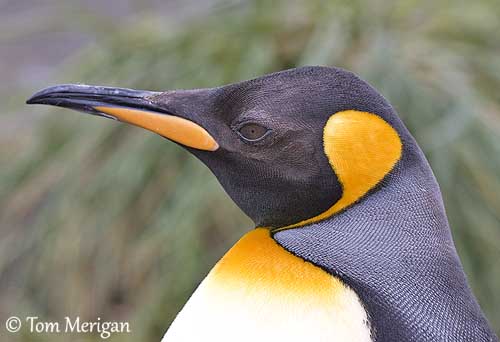
Aptenodytes patagonicus

Aptenodytes forsteri
The genus Pygoscelis includes three species with black and white plumage. Only the bare parts are coloured. They are smaller than previous, with a size of 70-80 centimetres. They have black head, with white head patch or markings. They are inshore feeders and are usually found in the higher latitudes of the sub-Antarctic and the Antarctic.
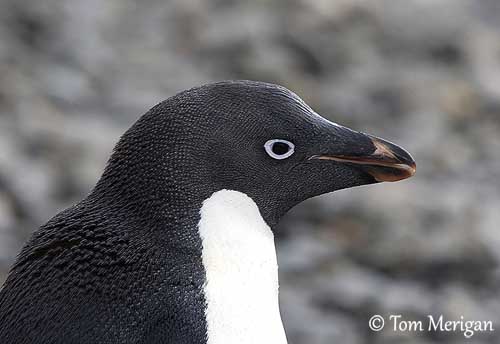
Pygoscelis adeliae
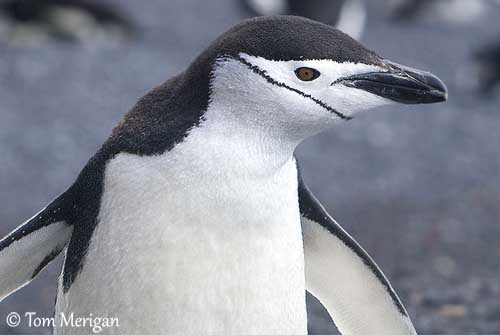
Pygoscelis antarcticus

Pygoscelis papua
The genus Eudyptes contains the crested penguins, smaller than both previous genera with sizes between 55 and 76 centimetres. Their yellow crests give them funny appearance and make them unmistakable. They have thick, deep red bill and eyes, and pink legs and feet. They are offshore feeders and dispersive, leaving the colonies outside the breeding season.
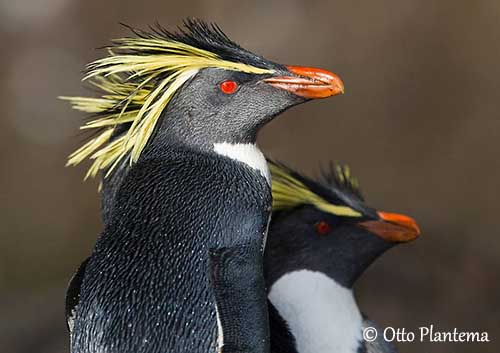
Eudyptes moseleyi
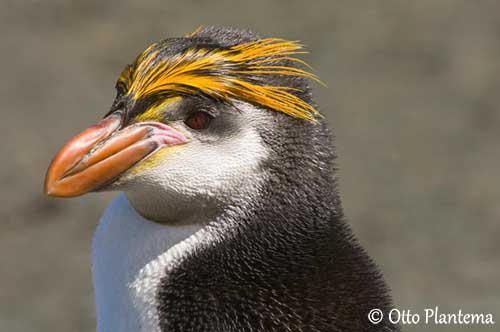
Eudyptes schlegeli
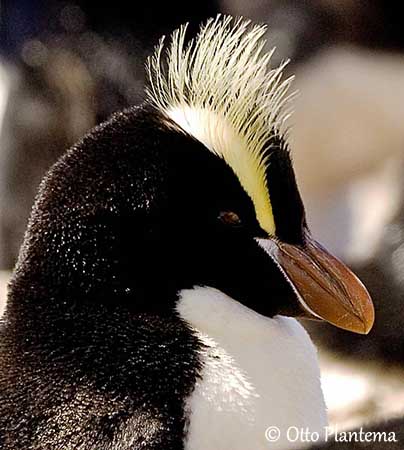
Eudyptes sclateri
The Yellow-eyed Penguin is the sole member of genus Megadytes. It is closely related to the previous crested penguins. This species has the yellow head feathers and the strong reddish bill of Eudyptes species, but its body plumage resembles Aptenodytes. Its size is about 66-76 centimetres. This species is endemic to New Zealand. It forages close inshore and adults are sedentary while the juveniles disperse northwards.
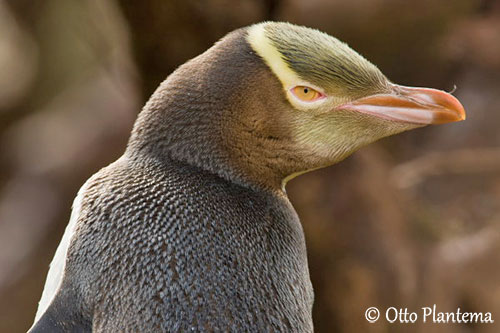
Megadyptes antipodes
The Little Penguin is also the sole member of genus Eudyptula. This one is the smallest of all species with a size of 40-45 centimetres. Its bluish plumage, its more horizontal stance and its nocturnal habits make it different from other species. It occurs from S Australia and Tasmania to New Zealand and adjacent islands.
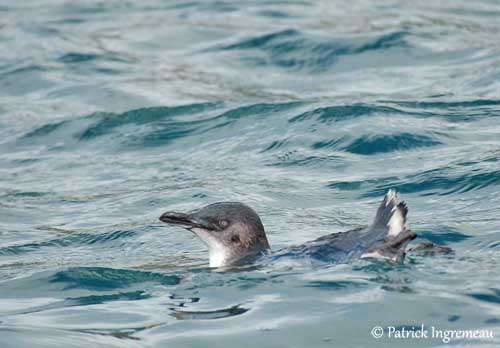
Eudyptula minor
The genus Spheniscus includes the four banded penguins, with black-and-white head pattern, a black band running along the black upperparts down the flanks, and pink bare skin on head, especially around the eyes or the bill. They have black bill, legs and feet. The size is about 48-76 centimetres. They are found in tropical areas such as Galapagos, South America and South Africa. However, cold currents occur close to the breeding ranges.
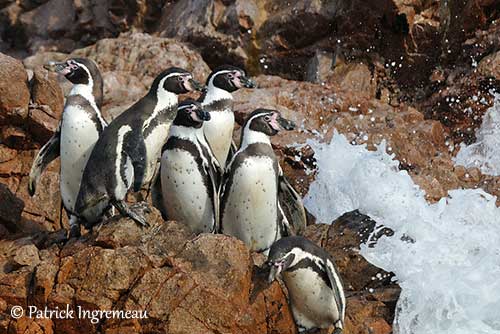
Spheniscus humboldti
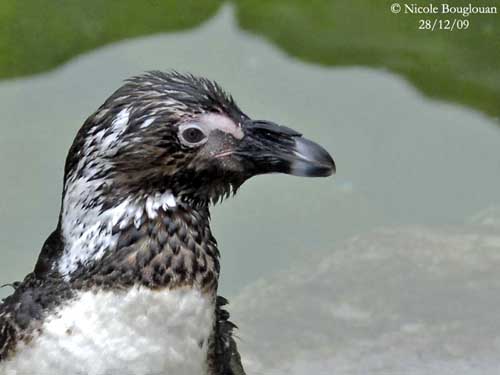
Spheniscus demersus
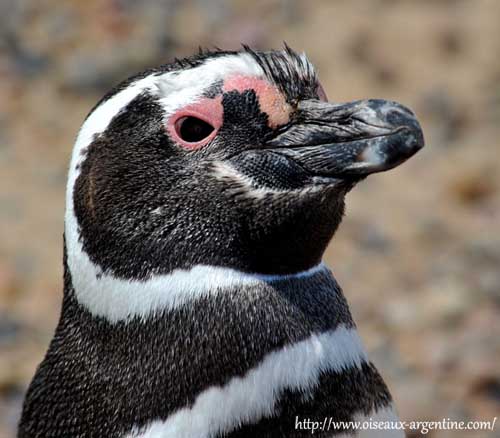
Spheniscus magellanicus
Penguins are marine and most of the species spend every year several months at sea. But they must come on land twice, for breeding and moulting. They often nest on coasts and islands, usually close to their feeding areas. They need an access relatively easy, but they are able to climb and jump thanks to their sharp claws.
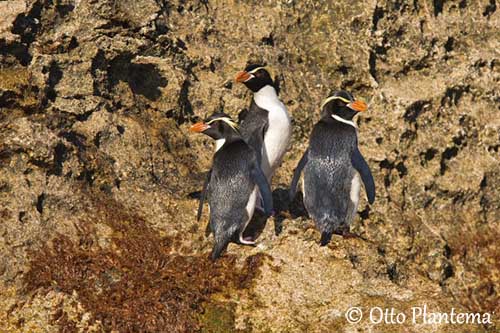
Eudyptes robustus
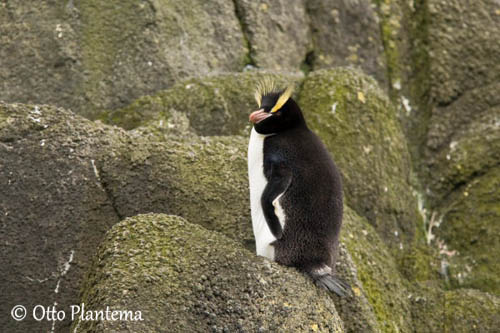
Eudyptes sclateri
The colonies can be established in wide variety of locations. The Emperor Penguin breeds on frozen seas whereas the King Penguin breeds on flat coastal plains near water. The Chinstrap Penguin and other Pygoscelis nest on steep slopes and ice-free rocky coasts. On the other hand, the Fiordland Penguin breeds in wet coastal rain forest, and the other Eudyptes species nest along the coasts, in rocks or lava fields, beaches, but also on grassy slopes and cliffs above the sea. The Little Penguin digs a hole in sand under thick vegetation while the Speniscus species nests in caves, cracks in the rocks or in burrows. The Yellow-eyed Penguin breeds in coastal forests and in densely vegetated areas near the coasts.
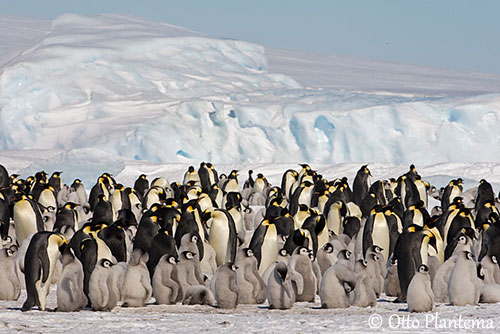
Aptenodytes forsteri
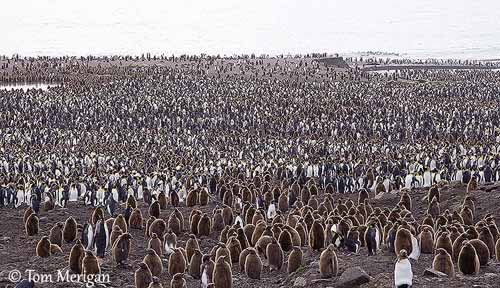
Aptenodytes patagonicus
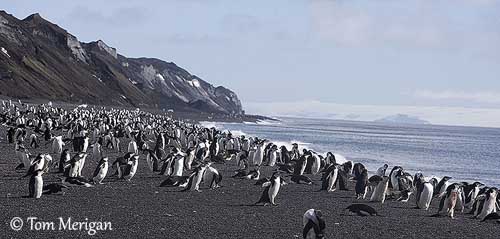
Pygoscelis antarcticus
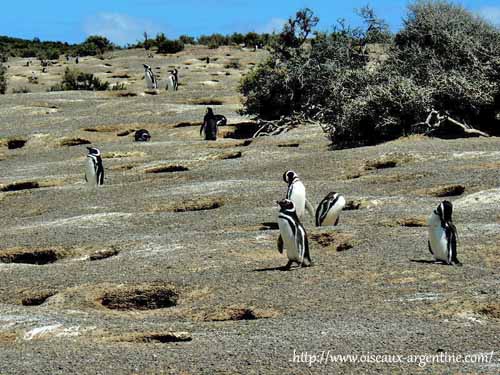
Spheniscus magellanicus
Their feeding areas are usually close to their breeding grounds. They exploit rich marine zones and feed primarily on krill, crustaceans, cephalopods and small fish. They hunt by pursuit-diving, and can reach great depths. Usually, penguins dive around 50-70 metres, with dives lasting about 2-5 minutes. However, the Emperor Penguin has been reported between 265 and 500 metres depth and may remain underwater during 15-18 minutes.
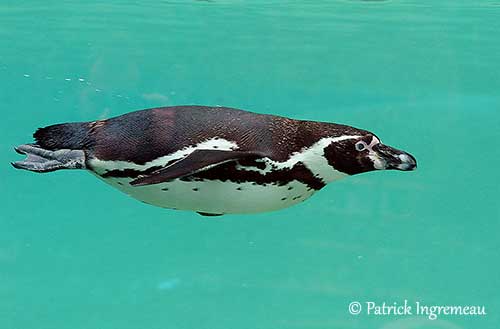
Spheniscus humboldti
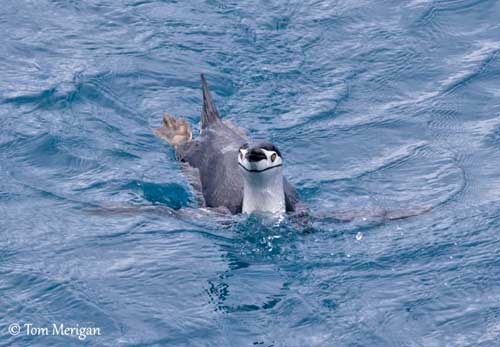
Pygoscelis antarcticus
They use three types of movements in the water. Surface-swimming is used for resting or toilet. This movement is not very rapid due to turbulences, and the penguin often raises head and tail out of water, with submerged body.
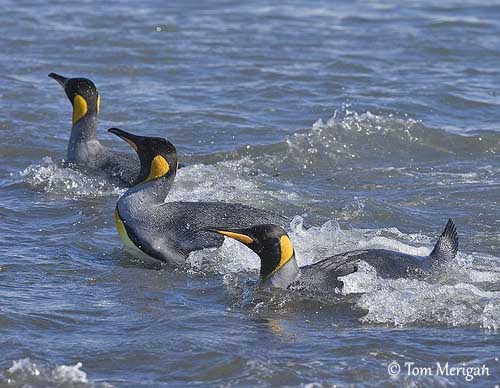
Aptenodytes patagonicus
Underwater-swimming is often compared to underwater-flying. The penguin performs movement similar to a bird flying in the air. It is propelled by flippers while tail and feet are used as rudder.
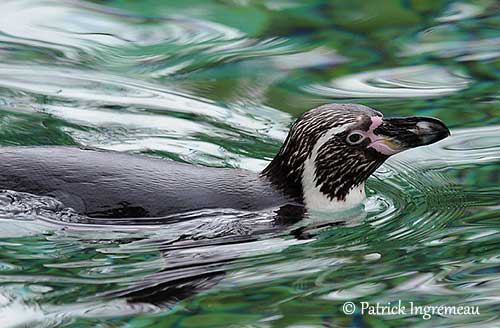
Spheniscus humboldti
The third mode is called “porpoising”. This is a form of surface-swimming with an undulating movement, regularly flopping in and out of the water. The Aptenodytes and the Spheniscus species do not use this movement or rarely, whereas it is frequently used by other genera.
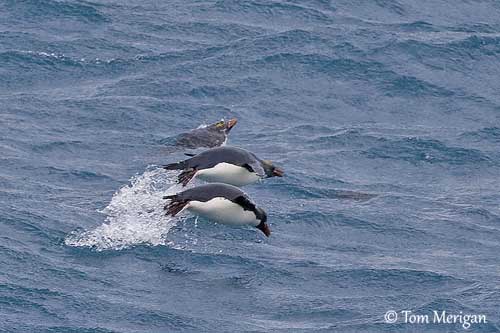
Eudyptes chrysolophus
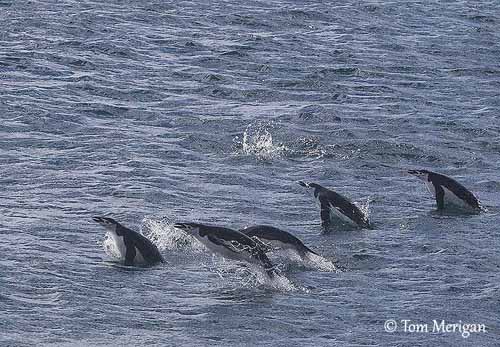
Pygoscelis antarcticus
Speeds vary from 14 km/h and 8km/h in Aptenodytes, to 7km/h in Adelie Penguin and African Penguin, and 2, 5 km/h in Little Penguin.
On land, penguins walk and waddle with clumsy gait. They walk with an upright stance, with short steps or hops. The species which breed in cliffs or rocky coasts climb strongly the steep slopes to reach the colonies, helping themselves sometimes with bill and tail. However, the largest species only walk.
The species living on ice can move faster by tobogganing, sliding on their bellies and pushing with flippers and feet.
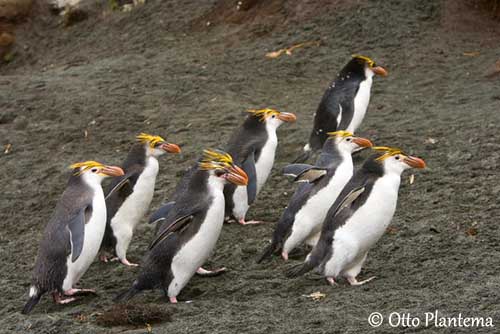
Eudyptes schlegeli
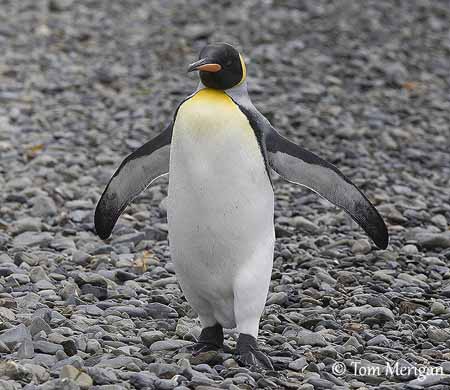
Aptenodytes patagonicus
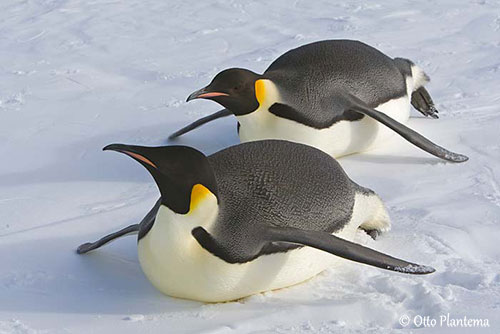
Aptenodytes forsteri
Penguins are gregarious. They often hunt in groups and breed in large colonies, except the Yellow-eyed Penguin with nests usually 20-30 metres apart, and the Little Penguin which sometimes nests solitary.
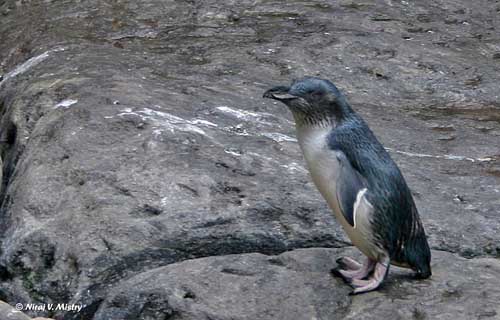
Eudyptula minor
According to the density of the colony, the behaviour can be different. In the huge colonies of Pygoscelis and Eudyptes, territorial and courtship displays are well developed. Recognition of partner or chick is possible through the complex system of visual and vocal signals.
The exception is the Emperor Penguin. In spite of high densities of up to 10 birds/m2 when males are incubating, the social behaviour is reduced in order to save the energy. They are living in extremely hard weather conditions, and they need all their energy to survive.
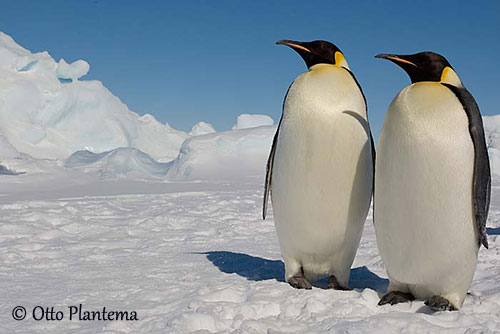
Aptenodytes forsteri
The formation of crèches is a great example of social behaviour, offering collective defence against predators, but also insulation in harsh climatic conditions.
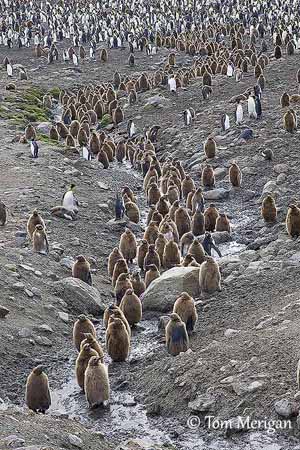
Aptenodytes patagonicus
But aggressive encounters may occur, and penguins adopt postures with raised crest in Eudyptes, while the head is lowered. They utter growling and barking. Sometimes, direct fighting may involve physical contact with locked bills. One bird may bite the opponent on the neck while beating it with the flippers. They also may use their bill to push at each other. This type of encounter is usually observed in nest-defence or between rivals.
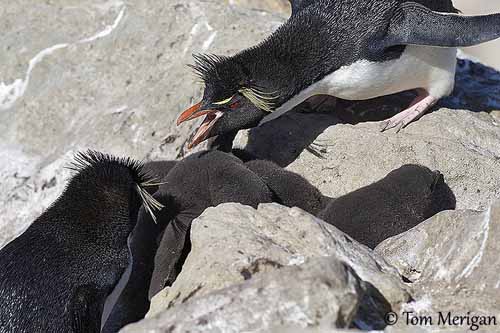
Eudyptes chrysocome
Other aggressive displays involve two birds facing each other, slightly lunged towards each other. The bill is wide open and they produce a hissing noise. A rival can be attacked from behind, by biting and gripping it at neck or back. These fights usually occur on land or in shallow water close to the shore, and rarely involve injuries.
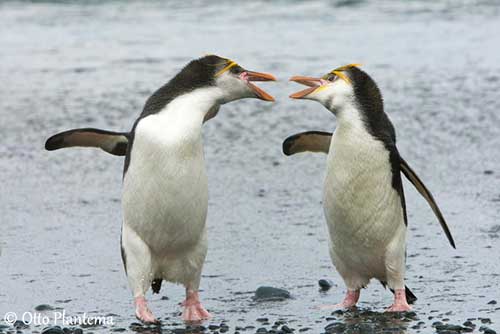
Eudyptes schlegeli
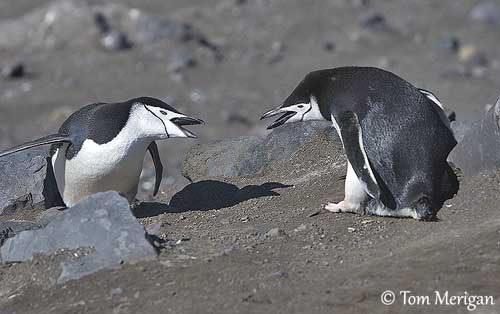
Pygoscelis antarcticus
The Yellow-eyed Penguin tries to avoid contact, but it defends its territory against other penguins. In aggression, it usually leans forwards towards the opponent with hunched shoulders, while making harsh noises. They sometimes charge and peck at a rival, but physical contacts are very rare.
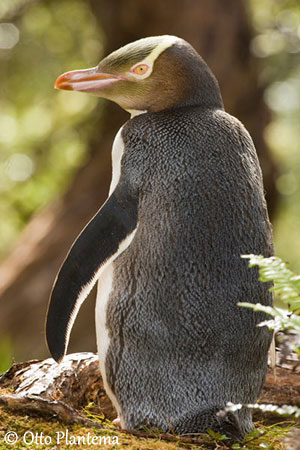
Megadyptes antipodes
Social behaviour is also recorded at sea, and several penguins, especially of genera Aptenodytes and Spheniscus, form groups for hunting and co-operate in the capture of preys, mainly around large shoals of fish. The Galapagos Penguin may fish in large flocks of up to 200 birds, but usually, most groups contain about 50 individuals. Their movements are highly synchronized while they move in and out of water in unison.
Penguins may hunt in association with other species such as seabirds (Gannets and Cormorants), sea lions and predatory fish.
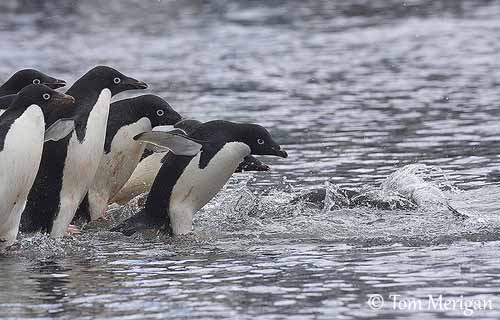
Pygoscelis adeliae
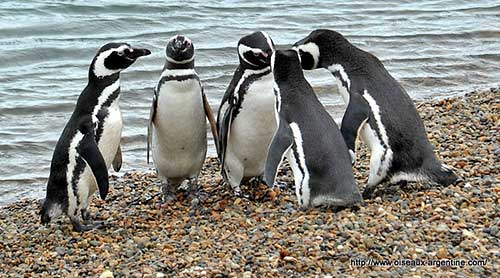
Spheniscus magellanicus
Penguins often breed in colonies of several hundreds or thousands of birds. This is the case of genus Aptenodytes, and Pygoscelis and Eudyptes may form large colonies too. The members of genus Spheniscus also breed in fairly large but smaller colonies. However, the Yellow-eyed Penguin usually nests in dense vegetation, in isolated pairs or small scattered groups. The Little Penguin forms loose colonies.
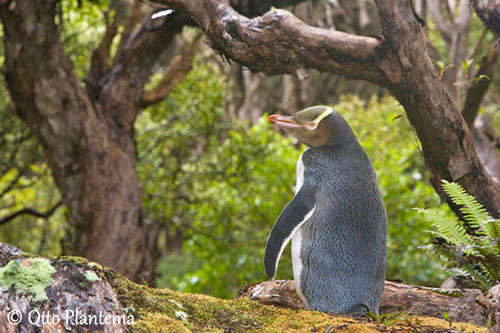
Megadyptes antipodes
Colonies need close areas with food availability and suitable nesting sites with good access. They are often along coasts or on islands.
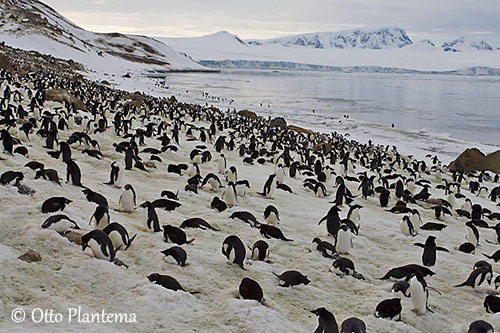
Pygoscelis adeliae
Penguins are highly seasonal in their breeding. But Galapagos Penguin, African Penguin and Humboldt Penguin can breed at any time, thanks to their subtropical and tropical ranges. The Emperor Penguin breeds during the austral winter when the sunlight is decreasing. The King Penguin breeds twice every three years, because a full cycle lasts more than one year. Pygoscelis and Eudyptes penguins may sometimes form mixed colonies.
They are faithful to their breeding sites and return every year to the same colony, or move slightly from year to year, maybe to allow the regeneration of the vegetation.
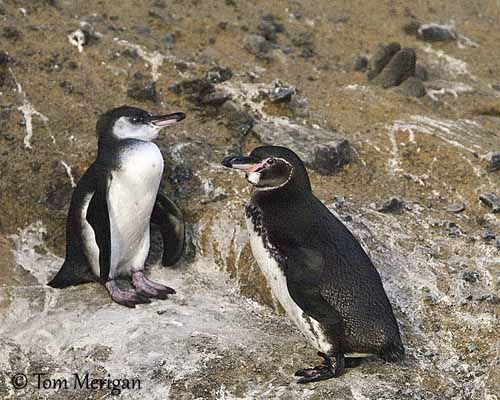
Spheniscus mendiculus
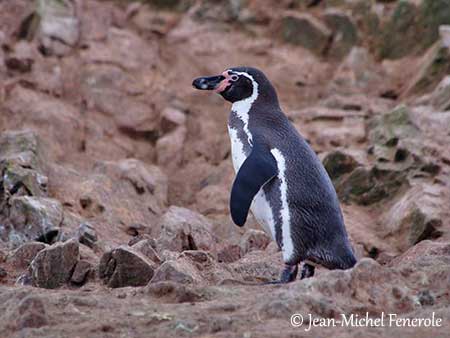
Spheniscus humboldti
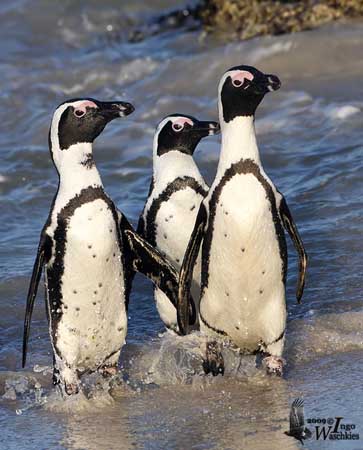
Spheniscus demersus
Penguins are monogamous. In several species, males arrive before females, and both partners join up at the same nest-site of the previous year. The male often starts the nest-building. Once the pair is formed again, courtship displays may start. There are usually several types of displays.
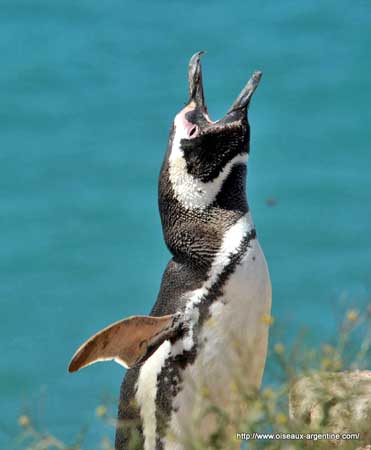
Spheniscus magellanicus
To attract a female, the male stands up with fully extended flippers. If she is attracted, she stays close to the male which bows. And she bows too. They continue these displays in order to strengthen the pair-bonds.
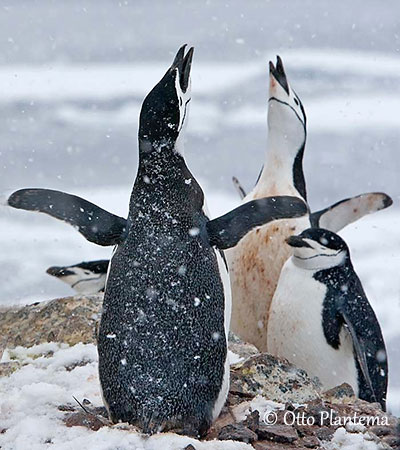
Pygoscelis antarcticus
The commonest is the ecstatic display with bill wide open. Other displays such as vertical head swinging side to side, shoulders hunched, quivering, bowing and mutual preening are performed too. All these displays are part of sexual behaviour and are performed prior to copulation.
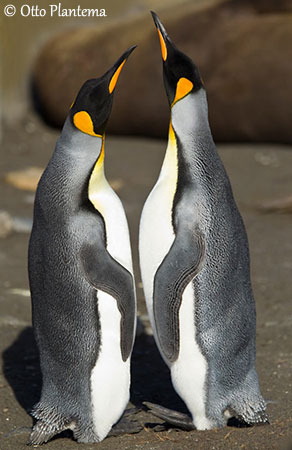
Aptenodytes patagonicus
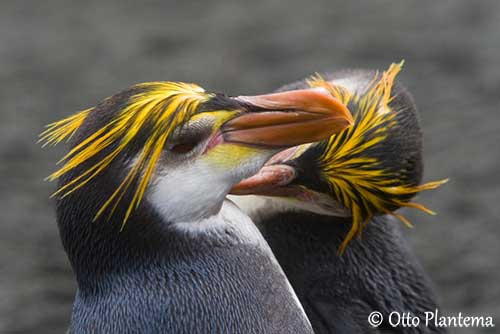
Eudyptes schlegeli
Courtship rituals include mutual preening, flipper weaving and bill duelling. Body movements and vocalizations are used for all types of communication.
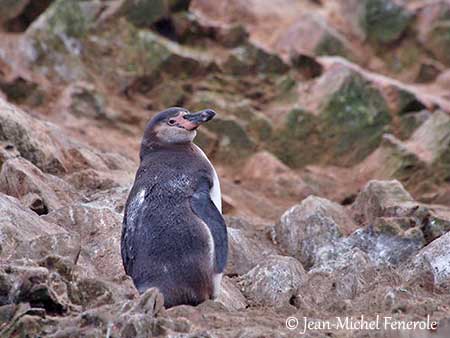
Spheniscus humboldti
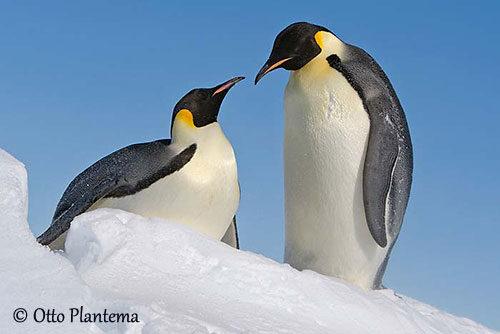
Aptenodytes forsteri
Sounds play an important role for recognition between mates and then, between parents and chick. This is their main communication system. We can hear three types of vocalization in Spheniscidae through barking, braying, hissing, growling and grunting.
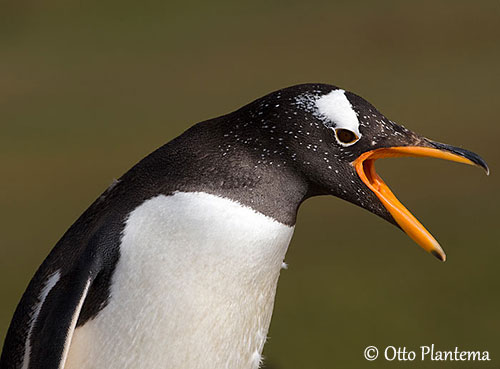
Pygoscelis papua
The contact call is used at sea by an individual, and helps in visual recognition within a group.
The display call is more complex and used between mates for sexual and individual recognition.
The threat call is used in territory defence or against predators.
As highly social birds, penguins have developed constant vocal exchanges, and colonies are noisy. Vocal signals are used both in defence and fights and of course during courtship displays.
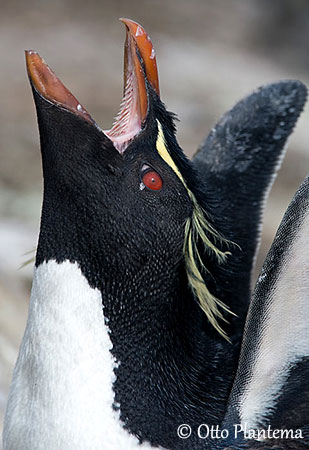
Eudyptes chrysocome
Some sounds by XENO-CANTO – Sharing Birds sounds from around the world
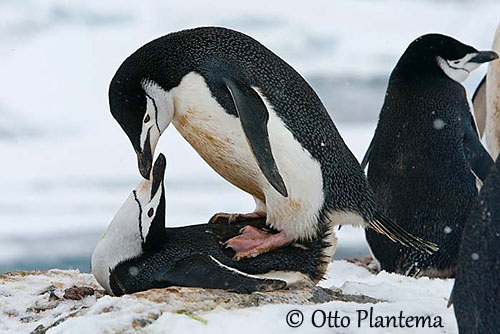
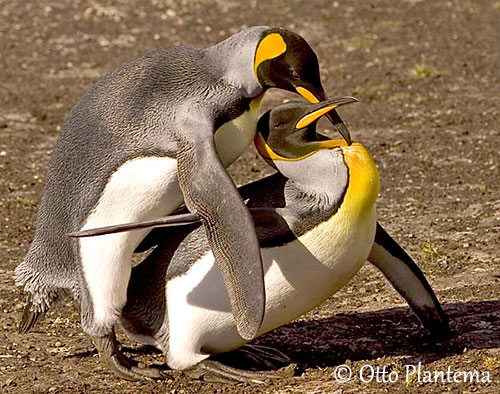
Pygoscelis antarcticus
Aptenodytes patagonicus
Penguins of genus Aptenodytes breed in huge colonies, the King Penguin on flat beaches free of ice, and the Emperor Penguin on stable pack ice, usually near the coasts. Colonies can be huge with several hundreds or thousands of birds.
Both species make no nest, and as soon as the female lays the single egg, she pushes it on the male’s feet. The egg is against the brood patch and kept warm during several weeks until it hatches. During the incubation, the female goes out at sea for feeding, and returns at time for hatching and feeding the chick. The male goes out at sea too during about 3-4 week to gain the weight he had lost during the incubating period.
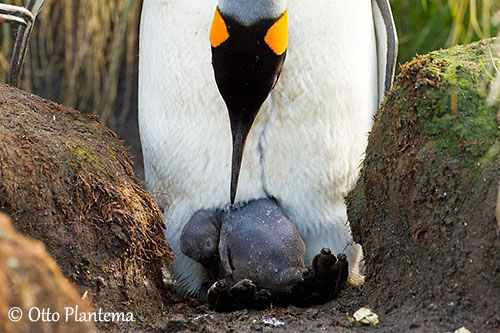
Aptenodytes patagonicus
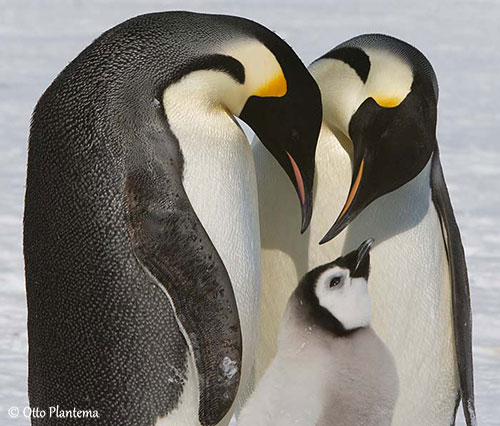
Aptenodytes forsteri
At 40-45 days old, the chick joins a crèche where both parents regularly feed it. Fledging occurs only at 10-13 months old in King Penguin, and at 5 months in Emperor Penguin.
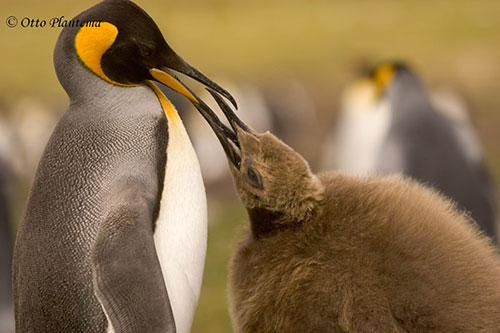
Aptenodytes patagonicus
As the latter is living in harsh weather conditions, the species has developed peculiar behaviour. During the winter months, the males remaining at colonies form a tightly-packed “turtle-formation”. The birds lean on each other and step by step, shift positions in order to benefit from the protected warmer area in the centre of the turtle formation.
The three species of genus Pygoscelis breed in colonies on rocky areas free of ice. The nest-site is on the ground and strongly defended. The Adelie Penguin may breed in large colonies and builds the nest slightly higher than other species. This is a depression in the ground lined with pebbles and stones, sometimes stolen from other nests.
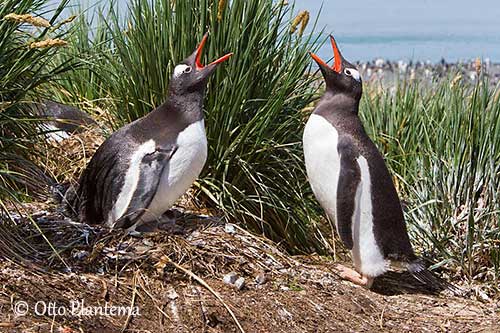
Pygoscelis papua
The Gentoo Penguin is the least colonial and the nests are spaced out. It is fairly large, made with stones, tussock grass and moss. There usually are hundreds of stones forming a circular pile. Both adults guard it against congeners which often steal pebbles.
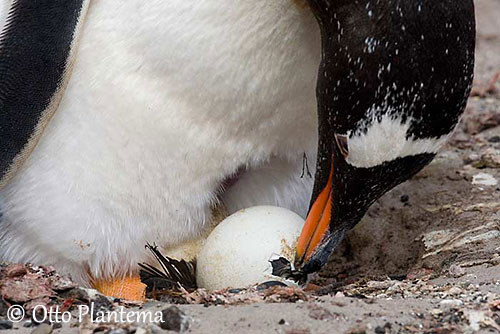
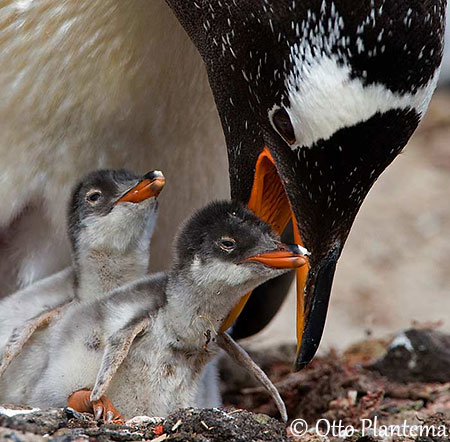
Pygoscelis papua
Pygoscelis papua
The Chinstrap Penguin breeds on rocky coasts, on steep slopes free of ice. Colonies can be huge and sometimes with mixed penguin species. The nest is on the ground, only made with a round platform of about ten stones.
Two eggs are laid and sometimes two chicks survive. Both sexes incubate during 35-40 days, with stints varying from 1-7 days to 1-18 days according to the species. The chicks join a crèche where both adults feed them by regurgitation. Fledging occur several weeks after hatching, with longer period of feeding after fledging in Gentoo Penguin.
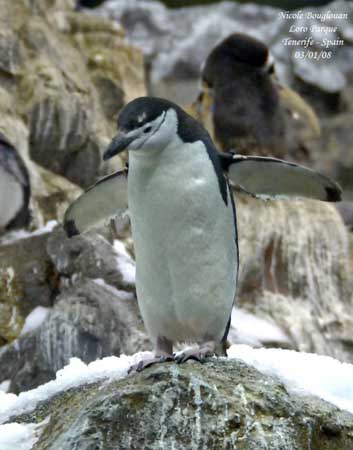
Pygoscelis antarcticus
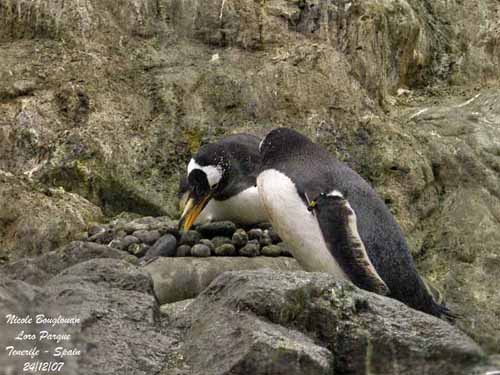
Pygoscelis papua
Penguins of genus Eudyptes form relatively large colonies with nests in the open or under vegetation, often on rocky coasts. The three species, Fiordland Penguin, Snares Penguin and Macaroni Penguin nest under bushes, trees or rocks, usually sheltered from sunlight. The four others, Erect-crested Penguin, Southern Rockhopper Penguin, Northern Rockhopper Penguin and Royal Penguin nest on rocky areas, cliffs and slopes.
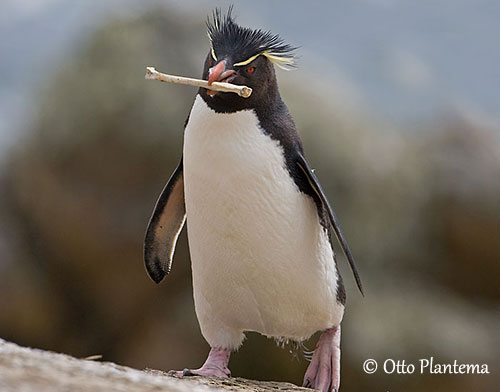
Eudyptes chrysocome
The nest is a depression made with stones, bones, pebbles, and plant materials if available in the surroundings. There is often a rim of small stones, or sometimes only a shallow depression in stones or sand.
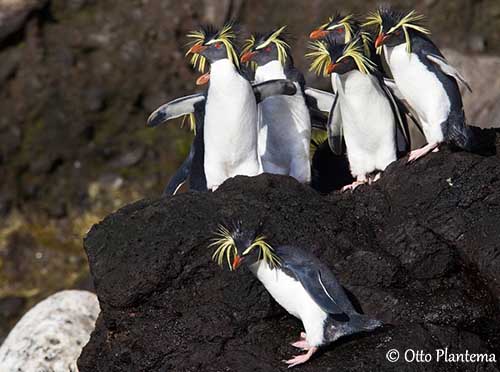
Eudyptes moseleyi
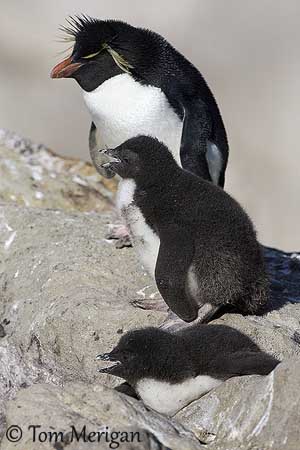
Eudyptes chrysocome
In species of genus Spheniscus, African Penguin, Humboldt Penguin and Galapagos Penguin breed all year round thanks to their ranges, whereas the Magellanic Penguin breeds between September and February. Their colonies are established on islands or on rocky areas of mainland coasts, on beaches, sandy hills and grassy slopes. The Galapagos Penguin is loosely colonial and may breed in small groups or solitary.
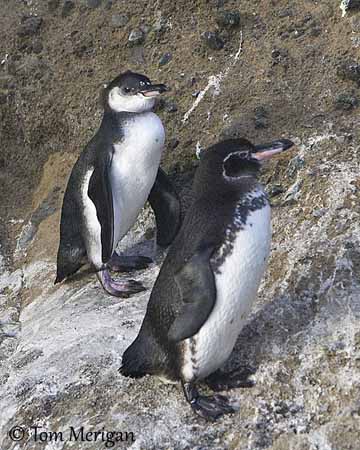
Spheniscus mendiculus
These species usually nests in holes, burrows, under rocks or roots, in cracks, rock crevices or caves in lava, in shade of vegetation to avoid the sunlight.
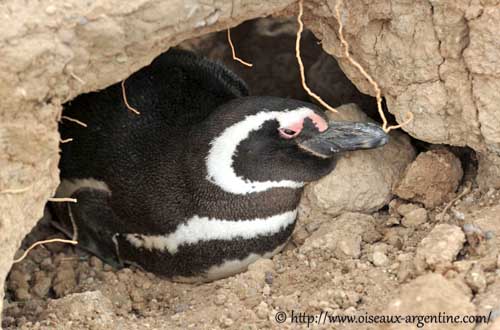
Spheniscus magellanicus
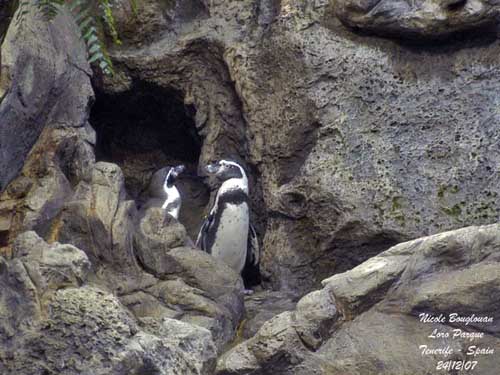
Spheniscus humboldti
They lay two eggs, and usually, both chicks survive. Even with larger first chick, both adults feed them equally, and once the first chick goes off to sea, the smaller it still fed by adults until it is able to feed itself. However, in Galapagos Penguin, only one chick is raised, but there is more than one clutch per year.
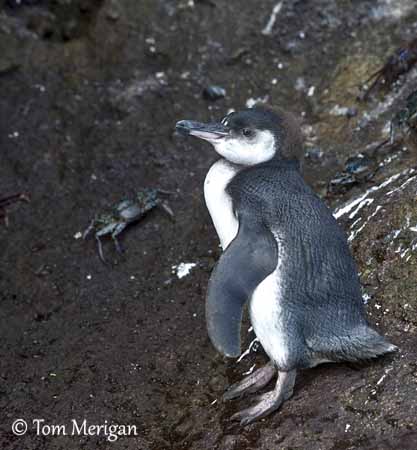
Both sexes incubate during 38-42 days with stints of 1-2 days, longer in Magellanic Penguin with stints of 2-22 days. The chicks may form small crèches and fledge between 60 and 80 days after hatching.
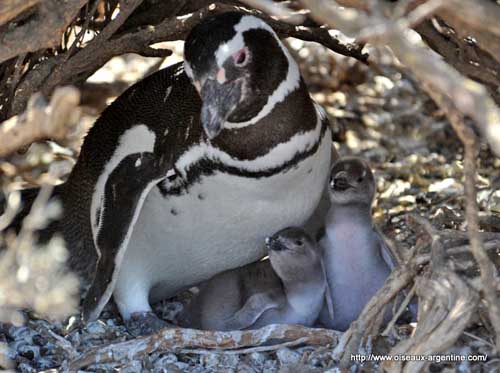
Spheniscus magellanicus
The Little Penguin breeds in colonies of high density of nests, although isolated breeding pair can be common. Colonies are established on sandy and rocky islands, at base of cliffs or in sand dunes. It nests in natural hollows or digs a burrow in sand. The nest-site is under vegetation or sometimes under human constructions.
They may breed in all months. The female lays two eggs, and often both chicks survive. Both parents share the incubation during 33 to 39 days, with shifts of 1-3 days. The chicks may form crèches of 3-6 birds when they are 30-35 days old. They fledge about 50-55 days after hatching.
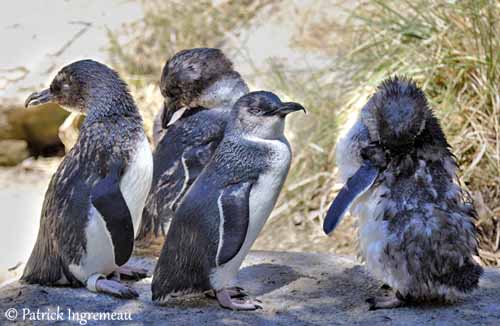
Eudyptula minor
The Yellow-eyed Penguin breeds in densely vegetated areas near the coasts, in slopes, gulleys or cliff top. The nest, a shallow bowl lined with dry plant matter and twigs, is often among vegetation or between roots. It may breed in loose colonies or solitary.
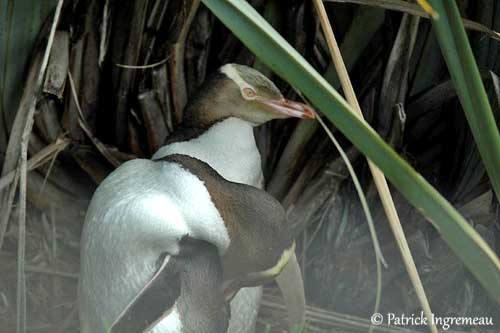
Megadyptes antipodes
The laying of two eggs occurs in September-October. Both sexes incubate during 39-51 days with stints of 1-7 days. There is no crèche. The chicks fledge between 97 and 119 days.
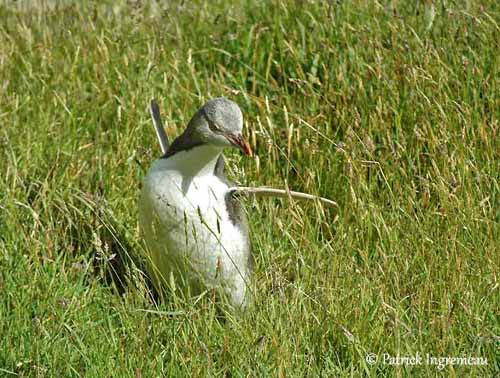
Adult penguins do not feed during incubation. For this reason, both parents take turns. While one of them is feeding at sea, the other remains at nest. If the foraging adult does not return or is absent too long, its mate leaves the nest and goes out at sea for feeding. However, the Emperor Penguin is the only member of this family which is able to feed the chick with “penguin milk” from its oesophagus if the return of the female is delayed. The chick can survive two weeks more with this milk.
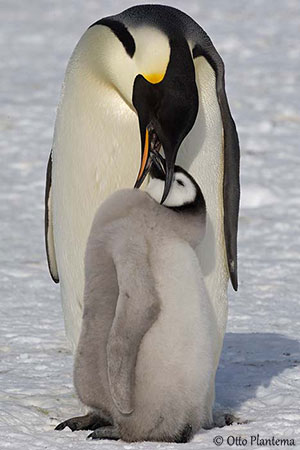
Aptenodytes forsteri
Once the chicks have fledged, the adults return at sea for feeding and gain the weight lost during the nesting period. They remain at seas some weeks, and then, they return on land for moulting. This period can last more than one month. After this period without feeding, penguins go out at sea again, and several species remain offshore, feeding and becoming fat before to breed again.
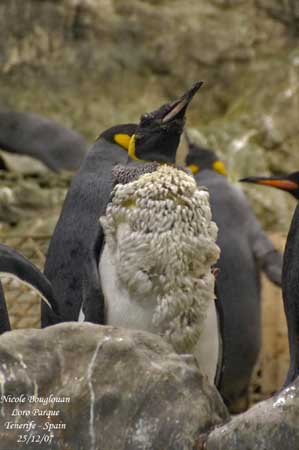
Aptenodytes patagonicus
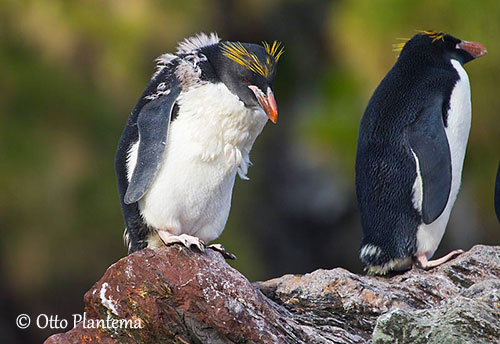
Eudyptes chrysolophus
Penguins living in tropical areas do not migrate and usually remain close to their colonies. Some dispersion can be reported according to food resources. But the species living in colder climate tend to move northwards. The Antarctic species move out the pack ice. But their movements need more information.
The young penguins may be vagrant or dispersive after fledging, but they usually return to their colonies for moulting and later, for breeding.
Largely due to their flightless condition, penguins were a source of food for humans, especially for whalers, fishermen and explorers through 19th and early 20th centuries, with devastated effects on populations. Egg collection on Falkland Islands ceased relatively recently, but this practice continues today on a small scale on Dassen Island off South Africa with the African Penguin, in spite of banning it in 1969.
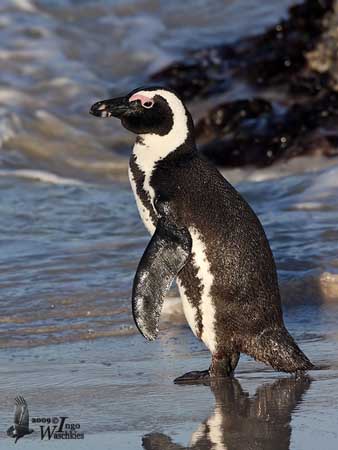
Spheniscus demersus
Penguins suffered extraction of their oil too. The birds were killed and boiled when they were fat, while returning to land for moulting. They were captured on Macquarie Island. Royal Penguin and King Penguin were killed in large numbers, and the latter was exterminated from the Falkland Islands. But due to protests from general public, the oil industry has ceased too. Guano collection has involved the destruction of the breeding grounds and the decrease of populations.
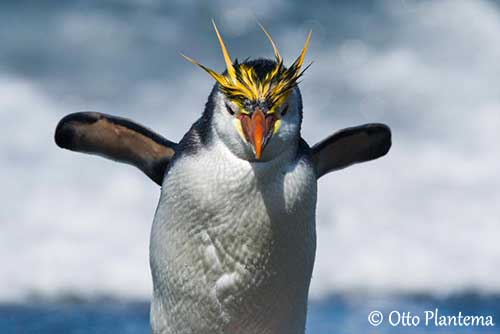
Eudyptes schlegeli
Zoos have taken large numbers of birds too, and although they played an important part in popularization of penguins, this success has helped to attract tourists through organized trips. People are often too close and make too much noise, involving negative effects on colonies.
The Spheniscidae species are disturbed by scientific bases usually established in suitable areas for breeding. Airplane traffic over the colonies spreads panic among penguins. All disturbances at colonies always have very serious effects. The adults leave their nests and trample chicks or eggs. Predators are attracted by injured and dead birds.
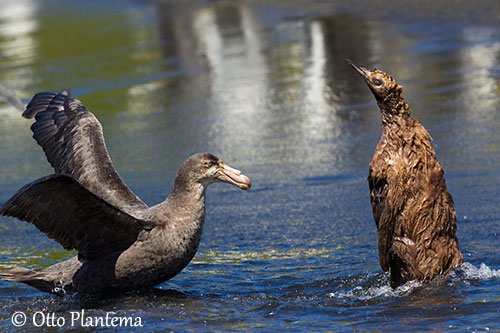
Introduced predators cause great losses. Rats, dogs, cats and pigs kill adults and chicks. Introduced sheep and rabbits cause deterioration of the habitat and loss of eggs by trampling.
The natural predators such as Skuas, Giant Petrels, Sheathbills, Leopard Sea Lions and Killer Whales, kill large numbers of adults at sea, and chicks on land.
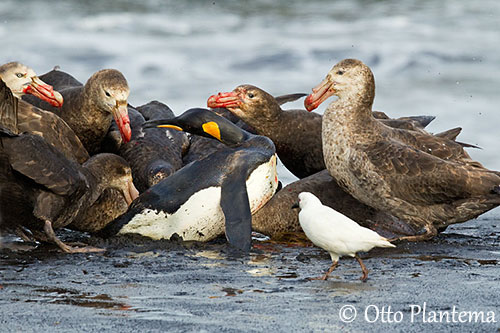
Oil pollution spoils the waterproofing of the plumage and destroys the layer of thermal insulation, plastic ingestion may cause injury or death, overfishing reduces the krill’s populations, climate change and marine factors affect penguins by variation of water temperature and reduction of preys.
All species have restricted range and in spite of huge colonies, the numbers are not sufficient to preserve the species.
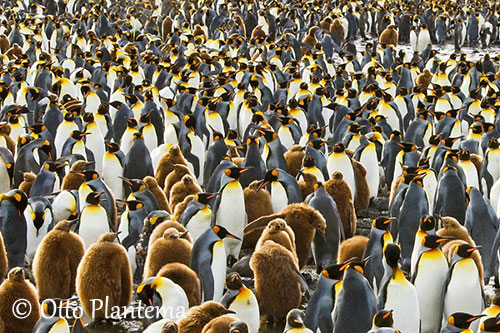
Aptenodytes patagonicus
Almost all species are listed as Endangered, Near Threatened or Vulnerable. Only two species are currently evaluated as Least Concern, the Little Penguin and the Chinstrap Penguin. But for how long…
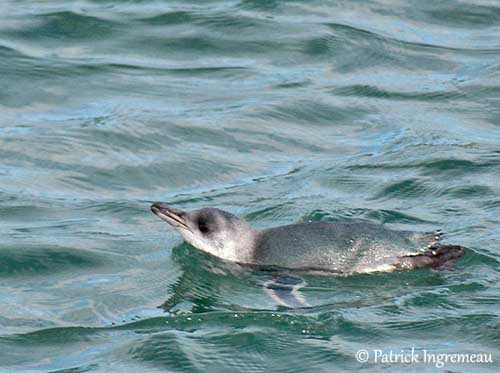
Eudyptula minor
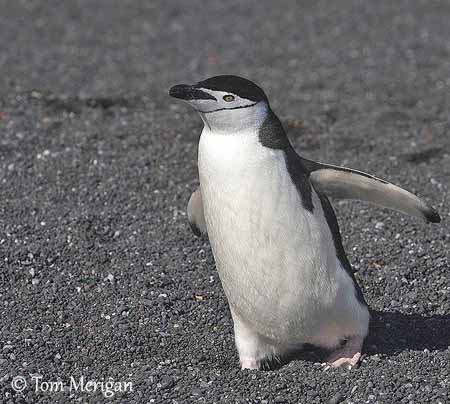
Pygoscelis antarcticus